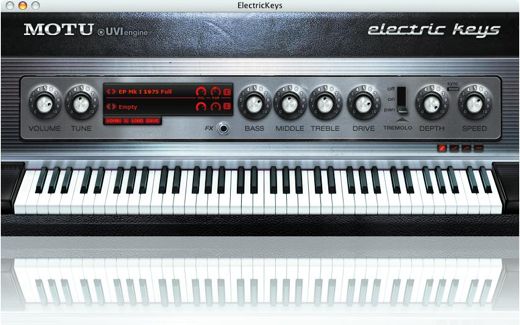
Winter NAMM Show Update: MOTU debuted Electric Keys, a $295 cross-platform virtual instrument that delivers the sounds of 50 classic keyboard instruments from the last 40 years.
The 40GB sound library includes over 20,000 24-bit 96 kHz multi-samples of electric pianos, electric organs, clavinets, Wurlitzers, tape samplers, string machines, keyboard basses and other rare and exotic electric keyboard instruments.
“You can play all those familiar electric keyboard riffs you know so well from the last four decades of rock, pop, funk and jazz, plus you get an intriguing assortment of rare and exotic keyboard sounds,” said MOTU’s Jim Cooper. “We carefully recorded and mastered the samples to the very highest standards for use in live performance and recording projects of any kind.”
The Instruments
Fifty well-preserved and maintained vintage instruments were used to create the sounds in Electric Keys, including models from Fender, Yamaha, Korg, Roland, Hammond, Wurlitzer, Hohner, Elka, Farfisa, Mellotron, Moog, RMI, Arp and others.
Most instrument samples are supplied at 24-bit 96 kHz resolution, but they can be played at any standard sample rate via Electric Keys’ flexible 32-bit UVI™ playback engine. Presets consist of carefully crafted multi-samples with multiple velocities, layers and/or release samples, depending on the instrument. Samples are streamed from disk, so even large presets load quickly and conserve computer memory. Sounds are organized in 12 banks, each with its own authentic look (“skin”), allowing users to install on their hard drive only the banks they wish to use. Electric Keys presets can be loaded into MachFive 2 for advanced sound design and layering.
The Interface
The Electric Keys window offers a few simple controls, including volume, pan, tone and tremolo settings, along with two preset slots, which allow users to layer two sounds using the convenient multi-column preset browser. When a preset loads, the background displays the “skin” for the corresponding bank, but the controls and their operation remain the same, regardless of the unique look and feel for each bank. Once one or two sounds are loaded, the user can simply play, adjusting parameters as desired, while CPU-efficient 256-note polyphony ensures that notes are never cut off due to voice-stealing.
All parameters can be automated via convenient “MIDI learn”, where the user can simply right-click any control to assign any MIDI controller. Users can load and save “combis” consisting of a snapshot of the entire plug-in, including effects. Combis can be shared among plug-in formats and the stand-alone version — even across computer platforms. Dozens of factory presets and combis are supplied.
The three-dimensional piano keys across the bottom of the Electric Keys window highlight during playback. Users can click the keys to audition sounds.
Separate multi-effects rack
Users can click the FX button to open the FX-Rack, which is a separate window with eight effects that can be applied individually or in combination as a multi-effect to any preset. Effects include amp simulation, filter, chorus, flanger, phaser, UVinyl (to add “wear and tear”), delay and reverb. Since effects can be loaded, created and saved independently of instrument presets, it is easy to mix and match effects with presets, allowing users to experiment with practically infinite combinations. All effects parameters can be automated with one-click “MIDI Learn” CC assignments.
Plug-in and stand-alone operation
Electric Keys supports all major plug-in formats on Mac OS X and Windows (XP and Vista), including VST, DXi, MAS, Audio Units and RTAS. It also runs as a stand-alone application, turning any laptop or desktop computer into the ultimate electric keyboard instrument.
Electric Keys will ship in February, 2008 for a list price of $295.
